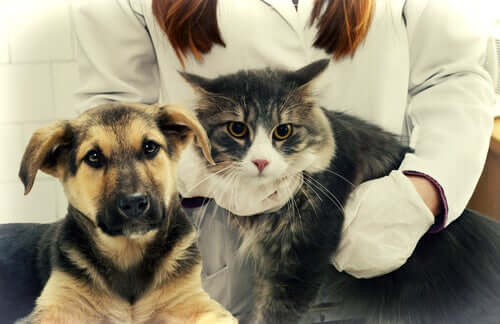Ascariasis in Cats and Dogs


Written and verified by the lawyer Francisco María García
Ascariasis in cats and dogs is suffered by about 40% of these animals, and timely treatment is vital to prevent further health complications.
As with many diseases, this condition is much more serious for puppies and kittens and can even lead to death if left untreated.
In order to diagnose ascariasis, an analysis of their feces will be necessary, so it’s essential that you go to the vet if you have any suspicions – the sooner the better.
The same applies if you suspect an infection. Early treatment is really important to avoid the infection spreading.
What is ascariasis in cats and dogs?
First of all, ascariasis is caused by two parasites, toxocara and toxoascaris leonina, which live in the animal’s small intestine.

It turns out that the parasite’s eggs are discarded in the dog or cat’s feces. However, these eggs mature and transform into larvae.
This means that the usual way that dogs are infected is through ingesting fecal matter, either by mistake or getting their legs dirty unintentionally.
Once inside the animal’s body, the larvae are released. They then travel to the liver through the bloodstream and pass through the lungs. Then they reach the trachea, continue down the esophagus, and end up in the stomach. Finally, they settle in the intestine, where they mature into adult worms.
What are the symptoms of ascariasis
The symptoms of ascariasis in cats and dogs are mainly coughs and diarrhea. They will also suffer from bloating and abdominal pain, weight loss, and growth problems.
In some cases, the situation may also be complicated by respiratory infections like pneumonia. Other animals have even developed gastroenteritis as a result of ascariasis.
As well as these respiratory infections, other serious conditions relating to this disease can include intestinal obstructions.
It goes without saying that if you noticed any of the above symptoms, you need to go straight to a specialist, who will determine the problem with a fecal examination. Depending on the results and a physical checkup, blood tests will be used if necessary.
How people can get infected
Ascariasis is common in rural areas or where there is a lot of land. Amongst other things, this is because they’re the places cats and dogs like to defecate.
This means that children between the ages of two and five are more likely to become infected due to ingesting fecal matter contained in the soil.
Just like with dogs, the larva travels through the person’s bloodstream and affects their organs. During the first phase of the disease, there are no obvious symptoms. But as the larva progresses things become more obvious.
In reality, the symptoms for people are very similar to those for animals – a cough, diarrhea, bloating, and growth problems.
How to prevent ascariasis in cats and dogs
It’s really important to stick to your pet’s deworming schedule. It’s also very important to remember to groom your dog after each walk.
Another form of prevention is to control their contact with other animals, especially if they don’t have owners, which means keeping your dog on a lead wherever necessary.

It’s also a good idea to avoid walking your dog within children’s play areas. It’s vital to take maximum precautions with the little ones. For example, it’s important that they wash their hands well after being in contact with a dog.
Ascariasis in puppies
- The biggest problem with ascariasis larvae is that they can pass through the placenta when a dog is pregnant and thus directly infect the fetus before birth.
- Once inside the puppy’s body, they make the same journey as in the body of an adult.
- The risk of death is higher in puppies because their immune system is not fully developed.
- Puppies can also become infected through the mother’s milk. The larvae travel through the mammary glands and that way find their way to the puppy.
- Both before and after a puppy is born, it’s important to take preventive measures to care for the mother and her young. Keeping the delivery area clean will decrease the risk of infection.
This text is provided for informational purposes only and does not replace consultation with a professional. If in doubt, consult your specialist.